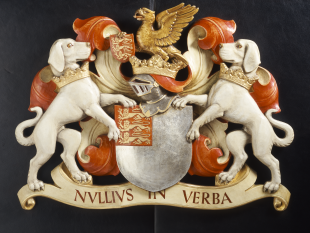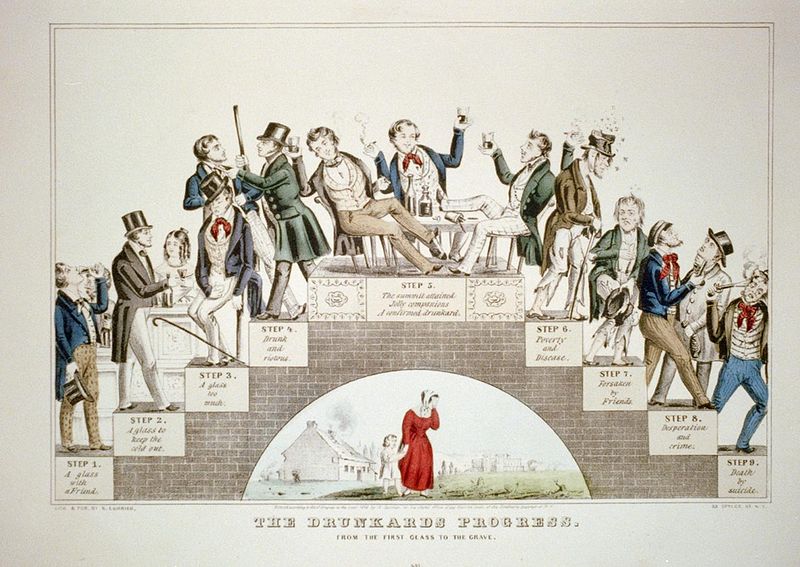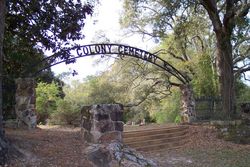Our story
This Chapter
A town named Merkelbach
Foreigner in Groszamerode
Merckelbachs by other names
Merckelbachs worldwide
Bibliography
Temper of the times
Footnotes
|
|
"That could be significant." Revision: December 21, 2011; data from December 2010 Three decades or so ago, Merkelbach was a small farming community eking out an existence in Germany's Westerwald. Since that time, with well-placed financial support, it has developed into a viable community of senior citizens with an overall population of about 435. Merkelbach lies right on Bundesstraße 413, which connects Bendorf, near Koblenz, to Hachenburg. The nearest Autobahn interchanges are in Dierdorf and Neuwied, names we encountered along the way up towards the Merkelbach clan's Grenzhausen branch. Peter Merckelbach and Margaretha NN. and their children lived in Dierdorf. Peter's brother Johann George, tenant of Hof Merckenbergh (later known as Hof Merckelbach) lived in Neuwied. 3A 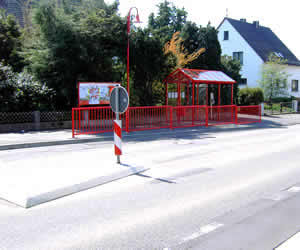
"Merkelbach — ist das nicht die 50 km/h Zone, vor Hachenburg" Wie böse Zungen scherzhaft behaupten. "Merkelbach? Isn't that the 50-km/hr zone just before reaching Hachenburg?" wags good-humoredly have it. Bundesstraße 413 is a rather busy road and it is good that, next to its bus stop, Merkelbach has for its school-age children a safe passage across it. 4 What else did we learn about this hamlet? That its existence was first documented in 1418 and that its origins were probably a stone's throw north-west from its present center, in the direction of Laad, wherever that is. And that its name derives from Markel and Bach; and that Markel is another word for Eichelhäher, a jay, presumably one that pecks away at acorns. And that it used to have another name, Merkelbeck—Jay's beak, I presume. And that meteorologists know its environs as the Merkelbach Regio which is full of web cameras used by hobbyists to track weather conditions.* 5 And, most endearingly, we noticed that Merkelbachers have a sense of humor, at any rate, those people who put up the community's website. 6  And on that note, we shall now leave Merckelbach in the Westerwaldkreis. But we leave it with a burning question: Is there more than one Merckelbach clan? Another one besides the one descending from Vaes Huyn of Amstenrode, one named after that tiny Merkelbach we just left behind? Or might it be that the name change from Merkelbeck to Merkelbach came about simply because so many Merkelbachs lived nearby? Somewhat like Johann Georg Merkelbach's Hof Merckenbergh made its small step to Hof Merckelbach by association with its tenant? Clearly, there is some unfinished business here that needs attending to. As they say in Merkelbach, the village: Wir arbeiten dran. We're working on it. 7 And on that note, we shall now leave Merckelbach in the Westerwaldkreis. But we leave it with a burning question: Is there more than one Merckelbach clan? Another one besides the one descending from Vaes Huyn of Amstenrode, one named after that tiny Merkelbach we just left behind? Or might it be that the name change from Merkelbeck to Merkelbach came about simply because so many Merkelbachs lived nearby? Somewhat like Johann Georg Merkelbach's Hof Merckenbergh made its small step to Hof Merckelbach by association with its tenant? Clearly, there is some unfinished business here that needs attending to. As they say in Merkelbach, the village: Wir arbeiten dran. We're working on it. 7I just love maps. They help us by filling out vague notions, gluing them together into a well-ordered whole. Here is a modern map of the region where most Mer(c)kelbachs have lived for centuries. It includes most of The Netherlands, Belgium, and Germany; it stretches from Groningen in the north to Strasbourg in the south so as to accommodate all our clan's branches. Pointer A marks the Merkelbach we visited a moment ago. 8  The region where still most Mer(c)kelbachs live. It is meant to serve as a reference to which more detailed maps can be compared. Recall that we showed a map like this one before, in Chapter 4.* 9 Moving on to our next map, it shows a "Googled" tour of where the Dahlen/Soest/Badenweiler and Grenzhausen branches used to live. The entire tour is within the borders of today's Germany. Point of this exercise is to see if geography supports our current understanding of this part of the Merckelbach genealogy. We'll begin in C, Dahlen (now Rheindahlen) and follow Gottfried Merckelbach to B, Soest where he became a prominent citizen. That is a distance of 160 km and the quality of roads in those days were a far cry from that of our roads today. Well, for the rest of the tour, why not simply tabulate it in its entirety. For clarity we need two maps, of different scales. 10 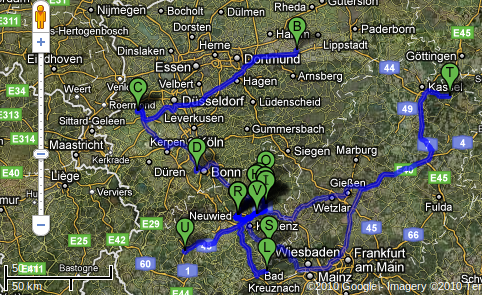 A tour of the places where members of the Dahlen/Soest and Grenzhausen branches lived. B Soest. C Dahlen. D Alfter. L Oberdiebach. O Merkelbach. R Neuwied. S Bogel. T Großalmerode. U Mehren. V Grenzhausen. 11 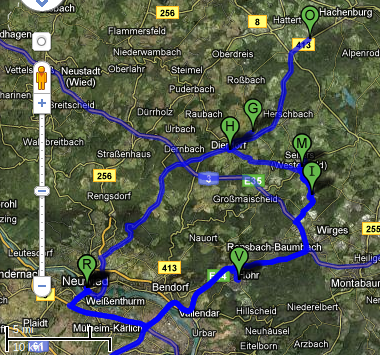 Magnification of an area in the above map to open up a clutter between markers. G Marienhausen. H Dierdorf. I Vielbach. M Selters. O Merkelbach. R Neuwied. V Grenzhausen. 12
C Dahlen (now Rheindahlen) - B Soest (160 km): Gottfried Merckelbach × Agathe Deppe Considering the extraordinary long distance from Bogel to Großalmerode, one might be concerned about the place of Peter M., the one who married Anna Catherina, in our family tree. Not to worry, however: Großamerode church records refer to this Peter as hailing from Koblenz (ref.). Peter's spouse, Anna Catharina, is from there, a subject we already touched on in the previous chapter. Finally, coming back to the question posed a few paragraphs back, do all persons thus far recorded as members of the Dahlen/Soest and Grenzhausen branches really are the only Mer(c)kelbachs to have lived there?—we still do not have a satisfactory answer. Up to this point it appears plausible they all do. 14 Another matter worth considering here is the current spread of Mer(c)kelbachs around the world. I do not know of any way to get precise information, but we ought to get a fair idea from consulting telephone books. Here are two maps obtained from the website of the Gouden Gids, the Dutch telephone book: 15 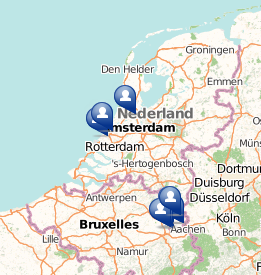 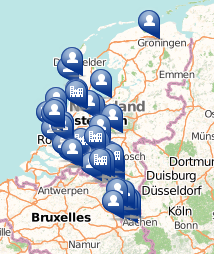 From the Dutch telephone book: Merckelbachs on the left; Merkelbachs on the right. (The images shown were captured in Dec. 2010; the links are current.) 16 A tabulation, made in Dec. 2010, that shows more detail may be in order:
For an instant we wondered about the relatively large number of Merkelbach telephone numbers in the province of North Branbant—63. Might that point to the origin of some other, distinct Merkelbach family? A closer look, however, revealed that 20 of them are found in the industrial city Eindhoven (think Philips!) and another 30 within a dozen km around Eindhoven. No reason, therefore, for suspecting there exists such a distinct family of Merkelbachs with origins in North Brabant. Their large concentration is purely a matter of jobs in an industrialized society. 17 As a next step, let's have a peek at adjoining Belgium and, especially, Germany. Belgium's telephone book lists 18 numbers for Marckelbach, 8 for Merkelbach, and 7 for Merckelbagh. And in Germany we find 232 numbers for Merkelbach but a surprisingly low 5 for Merckelbach, plus a solitary Merckelbagh. Here are two maps from 2008 that show the distribution of Merckelbach and Merkelbach numbers in Germany: 18 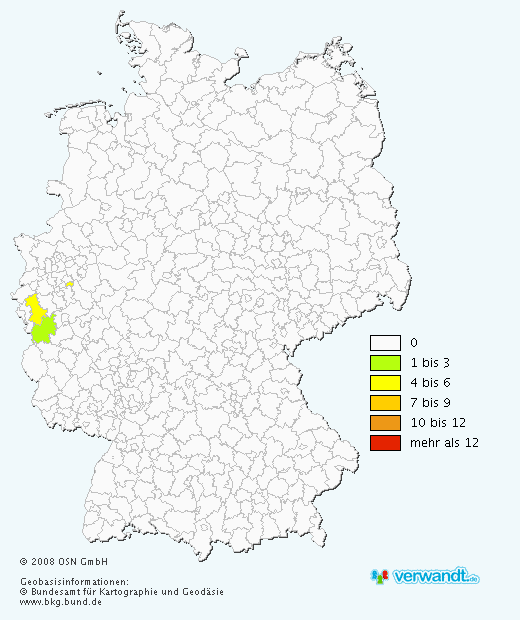 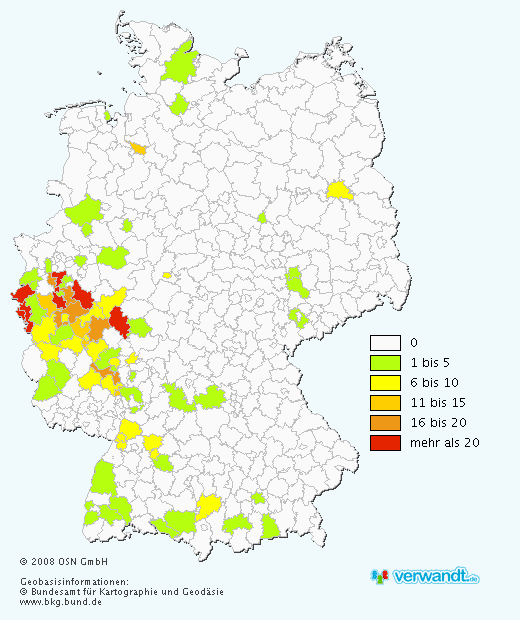 From Verwandt.de: Merckelbachs on the left; Merkelbachs on the right. (The images shown were captured in Dec. 2010; the links are current.) 19 In 1925, a Friedrich Wilhelm Merkelbach, who referred to himself as "Rektor, Essen-Altessen," prepared an extensive genealogy of the Grenzhausen branch. He credits a Prof. Dr. W. Merkelbach for his cooperation. With two such solid citizens, we should have in hand a reliable piece of work, a representation of which is found here in tree format. Progenitors of the branch are Johannes (or Johannes Henricus) Merkelbach and Maria Clauer. Johannes was born around 1630 and earned his living as an Eulermeister, a specialized potter, and who also served as a Kirchmeister (a person who took care of the local church, I guess). According to a genealogy prepared about 50 years later by a Wilmar Merkelbach, Johannes was the father of three sons and a daughter, although that older genealogy lists only one son, Peter. Going by that older, the rector's document, Peter fathered four sons over the period 1688 - 1700. The number of sons in subsequent generations were 11, 12, 19, 28, 36 and 41. Years of birth of those 41 descendants range from 1823 to 1922. The point I wish to make is that, considering that the numbers of offspring becoming more accurate with better retrieval of genealogical information over time, the growth of the Grenzhausen branch alone may well account for today's entire 232 telephone listings of the name Merkelbach. This then leaves a measly five Merckelbachs with a ck. Upon checking I found that they are living members of the Dutch Patriciate, a branch made up with many people who have greatly contributed to society and to whom a chapter is in the offing. 20 Where then are all those other Merckelbachs, the scions of the Dahlen/Soester/Badenweiler and Grenzhausen branches, the offspring of the Thimister/Frankenthal branches, the descendants of the Hottorf branch? As far as the ladies are concerned, they may have married and lived happily ever after under their husbands' names. But what about the men? Quite a few Marckelbachs, etc. live now not too far away from Thimister, but as for the other branches, their male lineages appear to have died out. Or they decided not to have telephones. Putting two and two together, all this accounting hardly leaves room for a distinct clan of Merkelbachs with its origin in Merkelbach! 21 There are some Merckelbachs scattered in other countries, notably in the United States, but also in Switzerland (tel. nos: 2 Merckelbach, 16 Merkelbach), Italy (?), and Korea (1?). Some other Marckelbachs used to live in Indonesia, before WW-II; there still may be some children of an Annie Marckelbach. Here is a record of Merkelbachs who arrived at Ellis Island, a small island in New York harbor, where from 1892 to 1954 over twelve million immigrants entered the United States:** 22
Berthe Merkelbach, single, age 25, from Liege, Belgium, arrived with the "Lapland" from Antwerp on Oct. 2, 1911. 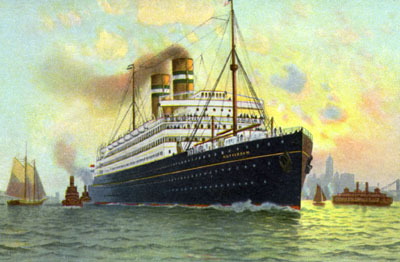
A chief engineer of the S.S. "Rotterdam IV" (1908-1940), a luxury liner of the Holland-Amerika line, was Antonius Merkelbach, born July 30, 1864 in Amsterdam, home address: Rochussenstraat 195, Rotterdam. Ellis Island records show he made nine visits during 1918–1919. (Painting by Fred Pansing. About the vessel. 23A The U.S. telephone book lists 69 numbers for Merkelbach and 5 numbers for Marckelbach. Wikipedia tells us that the first major emigration of Germans to America resulted in the founding of the Borough of Germantown in northwest Philadelphia County, Pennsylvania in 1683–1685. Mass emigration of Palatines began out of Germany in the early 18th century. In the spring of 1709, England's Queen Anne had granted refuge to about 7,000 Palatines who had sailed the Rhine to Rotterdam. From here about 3,000 were sent to America either directly, or through England, bound for William Penn's colony (Pennsylvania). The remaining refugees were sent to Ireland to strengthen the Protestant presence in the country. By 1710, large groups of Palatines had sailed from London, the last group of which was bound for New York. There were 3,200 Palatines on twelve ships that sailed for New York and approximately 470 died en route to America. In New York, under the new Governor, Robert Hunter, Palatines lived in camps and worked for British authorities to produce tar and pitch for the Royal Navy in return for their safe passage. They also served as a buffer on the frontier separating the French and Native Americans from the English colonies. In 1723, some 33 Palatine families, dissatisfied under Governor Hunter's rule, migrated from Schoharie, New York, along the Susquehanna River to Tulpehocken, Berks County, Pennsylvania, where other Palatines had settled. Another wave came during the Nine-Year War when French troopa devasted much of the Palatinate, a region East of the Rhine river. 24 A number of the Merkelbachs in the U.S. may well have descended from Hessian mercenaries who fought in the War of Independence (1775-1783) and decided to desert there rather than being shipped back to a rather unheimliche Heimat. Can't blame them, considering what we learned from the previous chapter's appendix. 25 Where are the descendants of those German refugees and deserters now? Let's consult the U.S. telephone directory again: about one-third of those 69 telephone numbers are in California; twenty in the New Jersey/New York area (remember, a large group of 17th-century migrants went to New York); a dozen in the states surrounding Pennsylvania, the remaining ones all over. I don't know how carefully American telephone books are put together, but four numbers are situated in the Canadian provinces Ontario and British Columbia! So, what about the so-called Pennsylvania Dutch (who are of German, not Dutch descend)? Not too many Merkelbachs among them, it appears. But then, the first wave of German migrants mentioned two paragraphs ago included Amish and Menonites (the "Plains People") from the Palatinate—probably not many Merkelbachs among them. 26 ... and so, going by the numbers, the evidence tends to indicate that this scribe married into one big, happy family. Except for an unexpected, itsy-bitsy, teenie-weenie detail. A Merkelbach living in North Brabant and a descendant of our Soldier of Orange had their DNAs compared. They were found to be not related. That could be significant. 27 Bibliography
|
|
Click on the map on this site called webcamgalore. * fn1 A fine map of the old-fasioned kind is the Atlas des Deutschen Reichs by Ludwig Ravenstein. The Memorial Library at the University of Wisconsin-Madison selected the 1883 copy as one of first in their digitization projects because of its usefulness for genealogists. The atlas helps in tracing the roots of families with origins in any part of the German empire from the late nineteenth century to the early twentieth century. Besides Germany, the maps of this atlas also cover the bordering portions of present-day Austria, Belgium, the Czech Republic, Denmark, France, Hungary, Lithuania, Luxembourg, the Netherlands, Poland, the Russian Federation, Slovakia, and Switzerland. I have no clear idea how useful it is, but it is a beautiful map that, for one thing, clearly shows the river valleys and thereby, presumably, preferred routes for travel. * fn2 Copies of the original manifests of chips anchoring at Ellis Island can be found here. * fn3 One of those immigrants was my favorite grandfather, Cornelis ("Kees") Koopman. He could tell stories, you wouldn't believe and never let mere facts stand in the way of regaling his narratives. He could sing too; Home, Home on the Range and Foster's My Old Kentucky Home. I still remember the lyrics of School days, school days, dear old golden rule days .... To get away from hassles with his wife's, somewhat uppity family, he had moved to Transvaal, one of two Dutch republics left after the English had captured the rest of South Africa. There he got caught up by the Second Boer War and shipped back to The Netherlands, courtesy Field Marshal The Rt. Hon. Sir Horatio Herbert Kitchener, 1st Earl Kitchener, KG, KP, GCB, OM, GCSI, GCMG, GCIE, ADC, PC (yes, the very one of poster fame, but that came later) whose scorched earth policy destroyed Boer farms, slaughtered livestock, and moved women, children and the elderly into concentration camps where tens of thousands perished. 
Even the Nazis imitated this poster, as did the U.S. Forest Service, think of "Smokey the Bear." (Source.) Back home, Kees decided to try his luck in America. On September 17, 1900, he arrived with the S.S. "Statendam" at Ellis Island, with wife and two two-year-old daughters plus all of 10 guilders (or dollars?). Immigration records show that he registered as a butcher. From his stories I know that he worked in a Chicago slaughterhouse. Life there was uncredibly hard as one may learn from Upton Sinclair's book "The Jungle." Subsequently, he moved to Fairhope, Alabama. Fairhope has, or until recently had, what was called, a single-tax colony. Land was leased from the corporation, tax diminishing upon development. The ideology behind this, it comes vaguely to mind, was something my grandfather was attracted to. My mother was born in Fairhope, January 16, 1908, one of the many Koopman children of which quite a few died as infants. A gravemarker in the Fairhope Colony Cemetery has the name Annie Koopman on it; no dates. Apparently, the Koopmans didn't do well in the States; eventually they went back to Holland. After WW-I, he migrated to an area near Metz in France. Farmland there was cheap with what ruins the war had left standing. Apparently that third migrant experience was no success either. But could he tell stories, you would't believe! He never let mere facts get in the way of regaling them. * fn4 |
--
| top of page |
|
Page maintenance:
Page format: Nov. 22, 2011
Story edit: Dec. 21, 2011
Timeliness
:data dated Dec. 2010
Reminders
find sources for Merckelbachs in Italy, France, Korea, Indonesia
Linkcheck: Not yet done. The application Linkchecker does not function under Ubuntu 11.10
XHTML verify: March 10, 2015
Backups: Dec. 17, 2011



